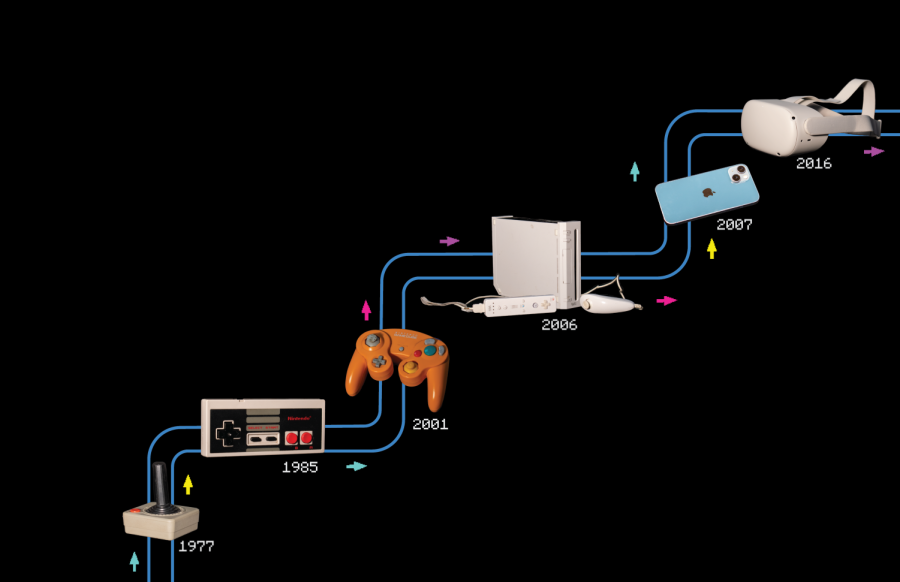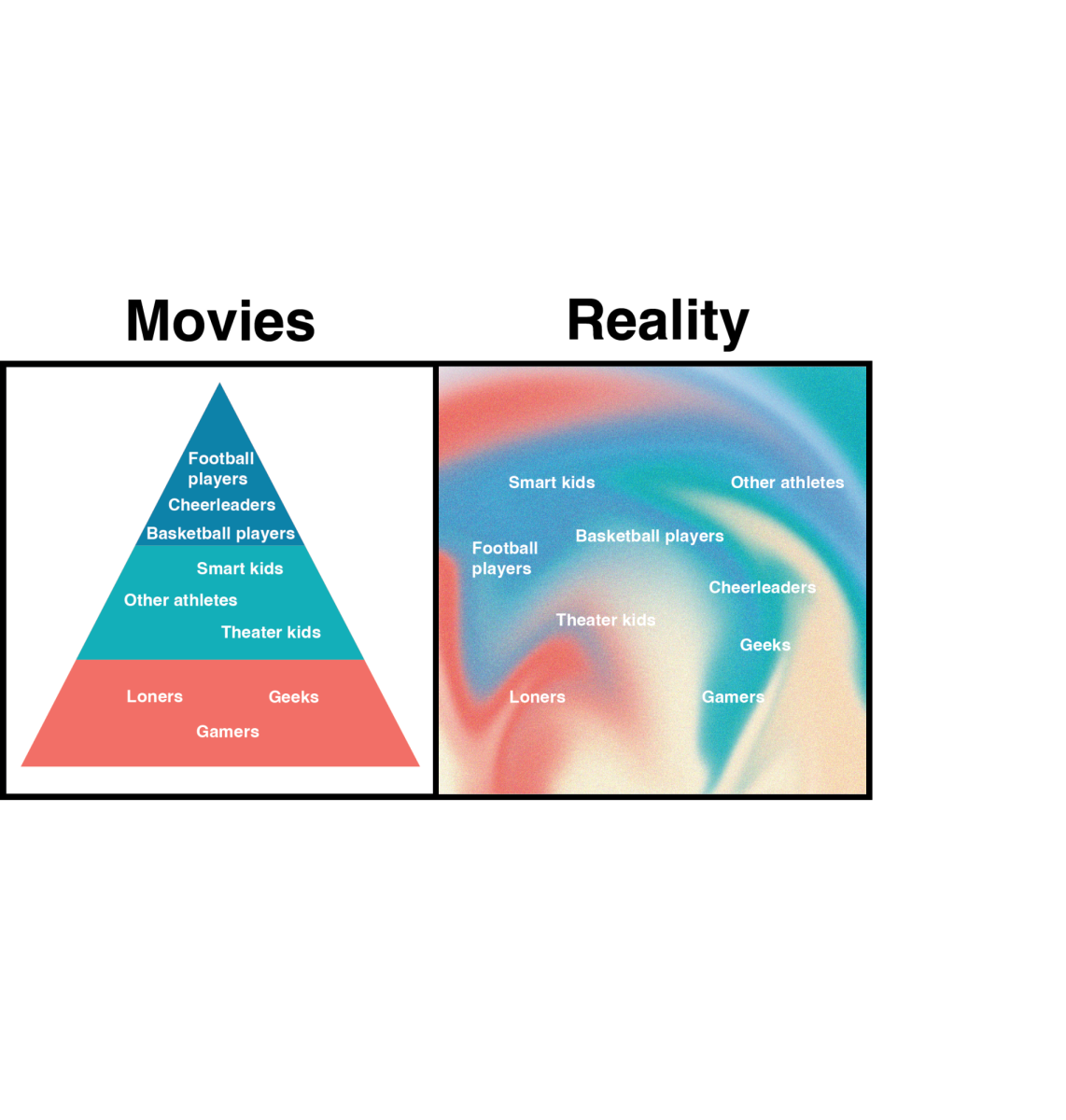In 1958, hundreds of excited people lined up in front of the Brookhaven National Laboratory to play the first ever video game. Its exhibit held the star of the show, Tennis for Two. In the sixty five years since, video games have evolved drastically across multiple generations, shaping the entertainment industry.
BABY BOOMERS – Origins
Tennis for Two displayed on an analog computer with two aluminum box-like controllers was created by American physicist William Higinbotham and was showcased in a three- day exhibition at a laboratory; the idea of a “video” game sparked many people’s interest. It portrayed a tennis match with two lines representing the court and the net as a player would hit the button that sent the ball over, and the other would try to receive it. This game set the stage for many more to come.
Despite video games existing in the late 1950s, they were scarce. Most baby boomers grew up away from technological entertainment and spent most of their childhoods outdoors.
“We played outside, came home from school and rode our bikes and did outdoor type of stuff,” fine arts teacher Janine Papin said. “Nobody ever stayed in… there was no sitting around unless you were doing homework or engaged in a project.”
When not playing outside, she spent her time creating crafts, drawing, painting and making up her theater shows. Papin never played video games and rarely watched TV.
GEN X – Beginnings
Arcades sprouted up and became a popular destination for children. In the 60’s, arcades mainly consisted of pinball machines but by the 70’s, more and more video games were created. Computer Space, made in 1971, was the first commercial coin operated arcade game. The popularity of these games inspired other companies to start creating video games.
One game in particular, Space Invaders, created in 1978 by the Japanese company Taito, captured the players’ attention with record sales. The 2D shooter game transfixed the audience, as the more challenging the levels got, the harder it was to stop shooting the colorful aliens.
“It was kind of easy to get hooked into playing an hour of Space Invaders, so I understand the allure of technology at large,” Garnett said.
As well as arcade games, the first at-home consoles were created in this generation. One of the first was the Magnavox Odyssey created in 1972.
“[They had] singular cords, all directional sticks, like a fixture in a car with a manual transmission,” Garnett said.
For once people did not have to spend time riding their bikes to the arcade and dealing with lines at their favorite arcade machine, instead they could simply play the games at home for hours on end. The most popular of them all was the Atari 2600 created in 1977. The variety of colors brought more life into the video games than the dull shades of previous consoles did.
Even with the improvements though, the graphics and diversity of the games were still very limited.
“They were pretty elementary, and the thrills were a victory,” Garnett said. “[They] were pretty minor compared to CGI and the interaction of gangs.”
With video games still considered rare at home and mostly located in arcades, the children of Gen X spent most of their time doing other things and only played video games
“They complimented being outdoors and doing stuff like being involved in sports, [like] waterskiing, Kids who are into dirt bike riding in the woods, the gaming was complimentary entertainment,” Garnett said
MILLENNIALS – Boom of Video Games
By the 80’s, video games became more and more popular, and companies were meeting the growing demand. With the Nintendo entertainment system, the Nintendo company dominated the industry with superior consoles that had better graphics, gameplay, sound, and color. Nintendo created many notorious games like Mario Brothers, Donkey Kong, Tetris, and more. By 1989, Nintendo’s newest handheld game console, the Game boy, became every child’s favorite Christmas gift.
“When Gameboy first came out, it was a big deal,” science teacher Bryan Moretz said. “I remember getting a Gameboy and playing things like Mario Brothers, and we have color.”
Competitions between companies to create better consoles and gaming experiences lead to a diverse selection of games. Many include classics like Mario Kart, Sonic the Hedgehog and Pokemon. Sports games like John Madden and roleplay games like The Legend of Zelda were all created in this time period.
“I remember in the early 90’s a lot of kids gaming,” Garnett said. “So in a decade, definitely had gotten pretty cool.”
GEN Z – Modern Video Games
As the rise of video games continued upwards, big companies like Sony and Microsoft joined the competition with their own consoles of Playstation and Xbox. PlayStation 2, became the best console of all time, selling almost 158 million units in 2000.
As well as consoles at home, PC games became accessible and relevant. A simple click of a button led to a smoothly run game with high quality graphics. In addition, the variety of consoles and games on the pc contributed to the increased playing of video games.
“Now that we have more console options, and people are willing to spend more money, a lot more people are playing, we used to have just the consoles like our Nintendo or GameCube, PlayStation,” Moretz said. “But now we can play games on computers.”
By the late 2000’s, video games now exist in every corner of society, with games on PC, consoles, TV, along with motion sensor technology and mobile games.
Especially with the accessibility of video games, they are played frequently as they have become the norm and apart of daily life with only a hand’s reach away.
“People do it in class if they’re bored,” Wermuth said. “You would like to do stuff at your house after your homework. It’s not like a big thing. It’s a lot of people’s hobby. It’s a lot of people’s way to relieve stress or to entertain themselves.”
As well as video games being a hobby source of entertainment, nowadays, playing video games can lead to something greater and potential opportunities.
“Nowadays there are Esports teams that people can play, there are tournaments, there are online competitions,” Moretz said. “Like when I was growing up, there was never even a thought that we would become like a game developer game designer, but nowadays that’s a very popular career choice that people move into.”
GEN ALPHA – The Future
As technology advances, the industry is headed toward virtual reality. With big companies like Facebook promoting VR, the 3D display headset will likely be the next big thing in video gaming. More than 214 million Americans play video games nowadays, far more than those who played Tennis for Two in 1958.
















